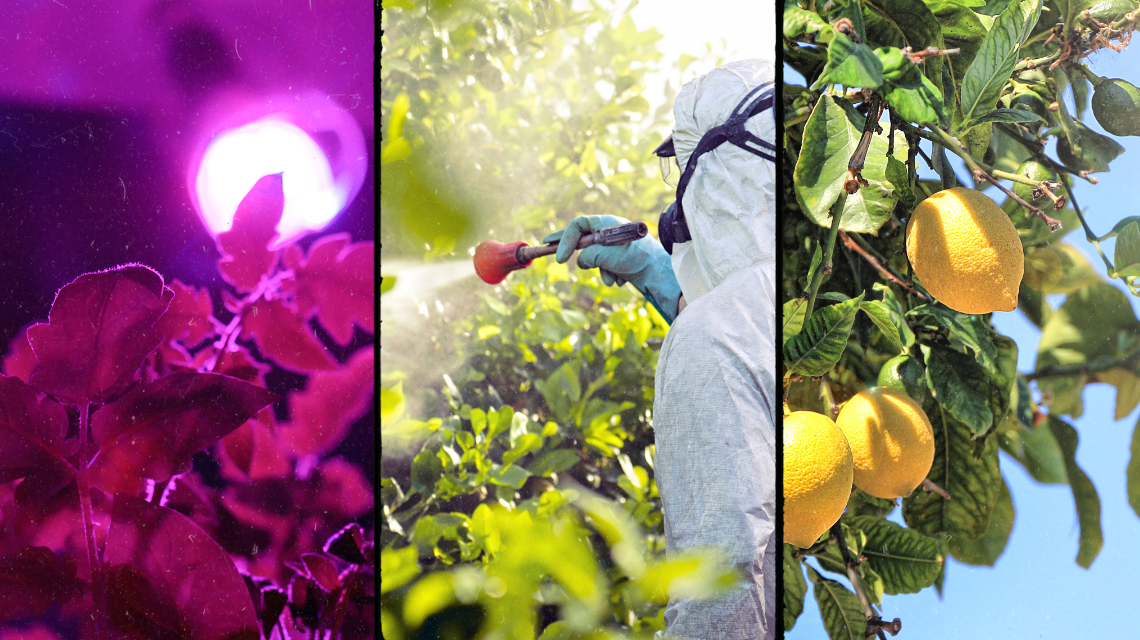Italian National Agency for New Technologies, Energy and Sustainable Economic Development

Agriculture: From ENEA new ultraviolet light technology to reduce use of pesticides
Ultraviolet treatment of fruit and vegetables to reduce the use of pesticides by 50% and boost their nutraceutical value and freshness is the objective of the ENEA research project "Ormesi", which envisages the design of a small remote-controlled robot to irradiate fruit and vegetables to increase their defense response and resistance to pathogens.
The first tests on basil, apples and lemons[1], treated with UV-C rays, showed improved resistance to common pathogens[2] that cause mold, paving the way for applications in greenhouses and on large crops.
“Laboratory work has shown that an appropriate dose of UV-C[3] ultraviolet light irradiated on plants and fruits induces greater resistance to pathogens and pre- and post-harvest diseases, since ultraviolet light creates a positive stress to which the plant reacts by producing specific metabolites which, by analogy, could be defined as 'antibodies' capable of increasing the plants' natural defenses and consequently their resistance to pathogens. This effect is known as 'hormesis', from which our project takes its name", explained Paolo Di Lazzaro at the ENEA Laboratory of Plasma Applications and Interdisciplinary Experiments, who is responsible for the research with Daniele Murra, Sarah Bollanti, Antonia Lai (Diagnostics and Metrology Laboratory) and Loretta Bacchetta (Bioproducts and Bioprocesses Laboratory).
ENEA researchers are also thinking of equipping the small robot with optical sensors capable of selectively recognizing the parts of the plant that require irradiation. “The creation of such a hi-tech system would allow the technology to be rapidly transferred to SMEs that manufacture, for example, tractors and drones for irrigation and phytosanitary treatment,” said Di Lazzaro.
“It is a fast, effective and sustainable alternative to pesticides which allows us to protect crops from viruses, fungi and bacteria and preserve their integrity, freshness and nutritional properties. Furthermore, this technique would make it possible to reduce soil, water and air pollution, as well as the health risk to farmers and consumers who would find fewer pesticide residues in their foods and drinks", pointed out Loretta Bacchetta.
UV-C irradiation of fruit and vegetables improves the anthocyanins and flavonoids content, with a consequent nutraceutical value increase, while it acts on polyamines -which inhibit ripening- extending the shelf life of products, with a positive impact on marketing. “The first results encourage further studies for the application of UV-C rays aimed at regulating the ripening process of fruit and vegetables with pre-harvest treatments, taking into account both practicality and economic convenience, and the increased nutraceutical component”, says Antonia Lai.
Specifically, 75 days after treatment the basil plants irradiated at low doses and then infected with the pathogen recorded a lower percentage of fungal development (30% of the leaf surface), compared to the inoculated and not irradiated basil (90%). “The results obtained so far show that the beneficial effect of UV-C radiation lasts over time” said Bacchetta.
In apples, UV-C rays slowed down the spread of the pathogen which causes decay. Encouraging preliminary results were also obtained in the lemon which, 40 days after treatment, showed complete inhibition of the pathogen, while the infected part, not treated with UV-C light, was invaded by the pathogen.
Around two million tonnes are used per year on a global basis, which cannot be completely washed off fruits and vegetables. The Farm to Fork document of the recent European Green Deal highlights the need to reduce the use of chemical pesticides in agriculture by 50% by 2030, underlining how chemical substances are a major source of pollution.
Photos and videos
Notes
[1] For the experiments, basil plants Ocimum basilicum (Genoese type), apples (Golden Delicious variety) and lemons (Femminello variety) from organic farming were used.
[2] The fungi were isolated from naturally infected material and later grown in vitro to obtain the sufficient amount for inoculation. Botrytis cinerea (grey mold) was isolated from infected basil plants, while Penicillium digitatum (green mold) was isolated from infected lemons.
[3] The UV-C band includes radiation with a wavelength between 200 and 280 nanometers, invisible to the human eye.
